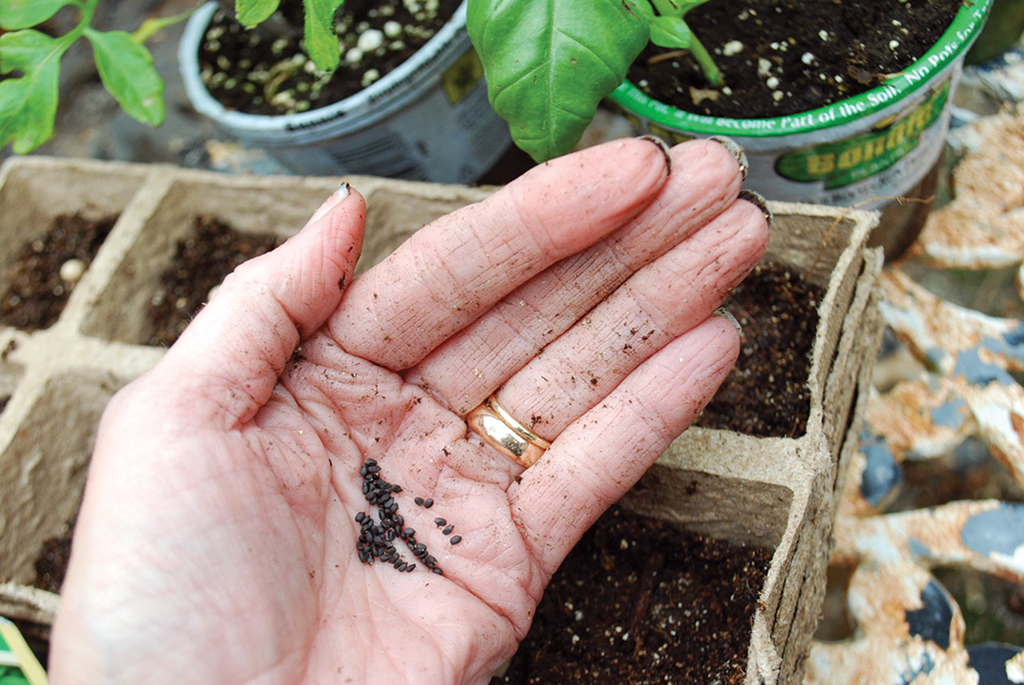
Now’s the time to start seeding for the season
By Katie Jackson
April heralds the start of the “serious” gardening season, which means it’s time to get serious about planting those late spring and summer annuals (and some perennials) that will grace our tables with food and flowers.
But should we be planting seeds or seedlings? The answer is some of both, but starting from seed offers a number of advantages.
Seedling transplants, also called “starts,” are in abundant supply at local garden centers these days and are often the easiest, most sure-fired way to get many plants, both edible and ornamental, to succeed. However, if you want to grow less mainstream varieties, such as heirloom plants, or want to save a little money, planting from seed is a great option. The key to seed success is getting those seeds started off right.
By now, soil and air temperatures are warm enough to plant many vegetables and flowers directly in the garden, a practice called direct seeding, which is often ideal for large-seeded plants such as squash, peas and melons as well as such flowers as sunflowers and marigolds. Certainly, even small-seeded plants like tomatoes, peppers and a number of other herbs and flowers can be sown directly into well-prepared beds. But giving many plants a leg up by starting them in containers often helps.
Start with the correct growing container
Start your own seedling nursery by choosing some appropriate growing containers such as peat pots or reusable seed-starting trays or even repurposed items like paper cups, slated wooden boxes, small pots or yogurt, milk and egg cartons. Any container that is at least a couple of inches deep and has drainage holes in the bottom will do, though repurposed containers should be thoroughly washed and disinfected in a diluted bleach solution (nine parts water to one part bleach) before they are used.
Aside from the seeds, the most important ingredient for seed-starting success is a high-quality growing media. Do not use yard or garden soil as it may contain pathogens or pests that can harm sprouting plants. Instead, use a sterile media such as prepackaged seed-starting mixes or a homemade media of equal parts peat moss, vermiculite and perlite.

If you want to save a little money, planting from seed is a great option
Fill each container at least three-fourths full with the growing media (it often helps to wet the media before you put it in the containers, though make sure it is moist, not soggy). Press it in firmly into the containers to eliminate any air pockets then follow the recommended planting instructions found on each seed packet. Typically larger seeds are buried about two times deeper than their width while smaller seeds are sprinkled on top of the growing media then lightly covered with another thin layer of media.
Place the seed containers in a sunny spot (this time of year that can be indoors or out) that has good air circulation but is protected from harsh winds or hard rains. Water the containers lightly about once a week or when the top of the growing media is dry to the touch, but be careful not to overwater — soggy growing media can promote diseases or rot the seed. Once the seedlings emerge, apply a small dose of balanced liquid fertilizer to give them a little extra boost as they grow.
Most seedlings are ready to transplant when they have produced two to three “true” leaves (the first leaves that emerge are cotyledons or “seed leaves”; the second set and all thereafter are “true” leaves). Try to plant the seedlings in the garden late in the afternoon on a calm, overcast or cloudy day so they won’t be stressed by sun, heat or wind as they acclimate to their new surroundings.
If you direct-seed into the garden, make sure your beds are fully prepared and pre-moisten the soil before planting or water gently just after planting, then keep the soil moist (again, not too wet) until the new plants emerge. Applying a thin layer of mulch will help retain moisture around the seeds, though once seedlings begin to pop their heads up, make sure the mulch does not hinder their growth.
Whichever method you use, you may have to thin the new plants once they come up so they won’t be overcrowded, but you can move the extra seedlings to pots or to other spots in the garden if you can’t bring yourself to toss them out. And once those little darlings are up and thriving, you can take great pleasure in seeing your hand-raised garden grow.
[list]
April Tips
- Plant peas, Irish potatoes, strawberries, blueberries, raspberries and blackberries.
- Sow seeds for beans, corn, squash, melons and other summer vegetable crops.
- Begin planting tomatoes, peppers and eggplants once the threat of a hard freeze is past.
- Weed garden beds.
- Fertilize warm-season lawns and plant new lawns.
- Plant summer annual flowers and summer-blooming bulbs.
- Prune spring-flowering shrubs such as spirea, flowering quince, azalea, jasmine and forsythia after they have bloomed.
- Clean dust from the leaves of indoor plants.
- Plant container-grown roses and keep an eye out for insect and disease problems on all roses.
- Start a new compost pile and turn the contents of existing ones.
[/list]
 Katie Jackson is a freelance writer and editor based in Opelika, Alabama. Contact her at katielamarjackson@gmail.com.
Katie Jackson is a freelance writer and editor based in Opelika, Alabama. Contact her at katielamarjackson@gmail.com.





